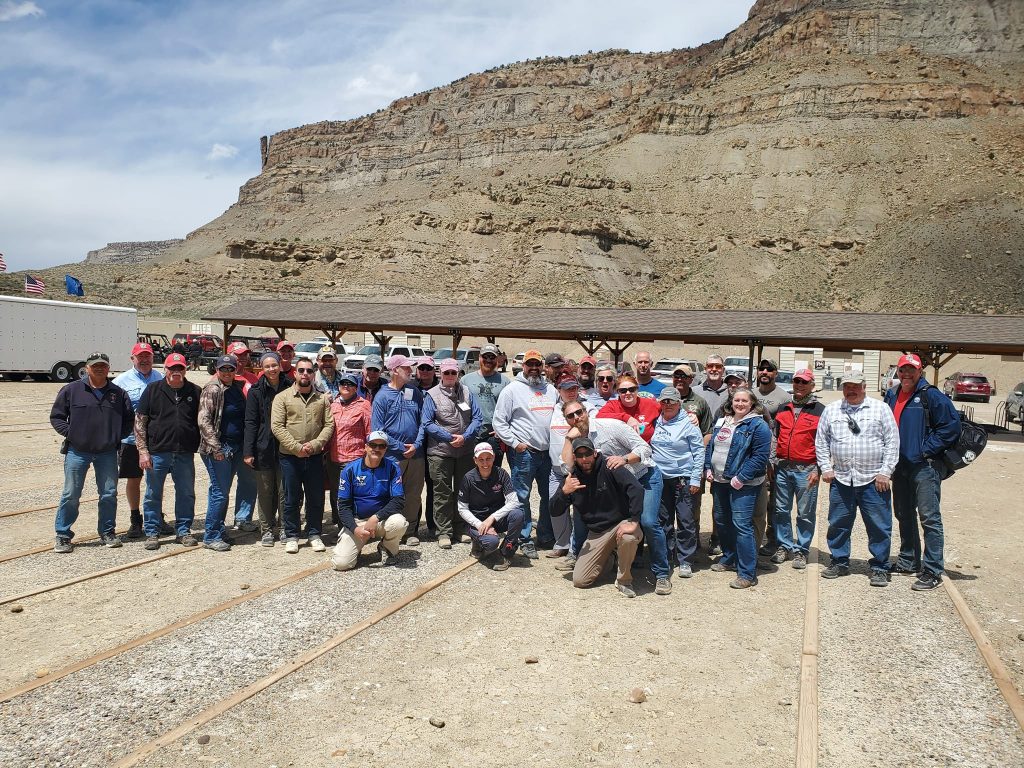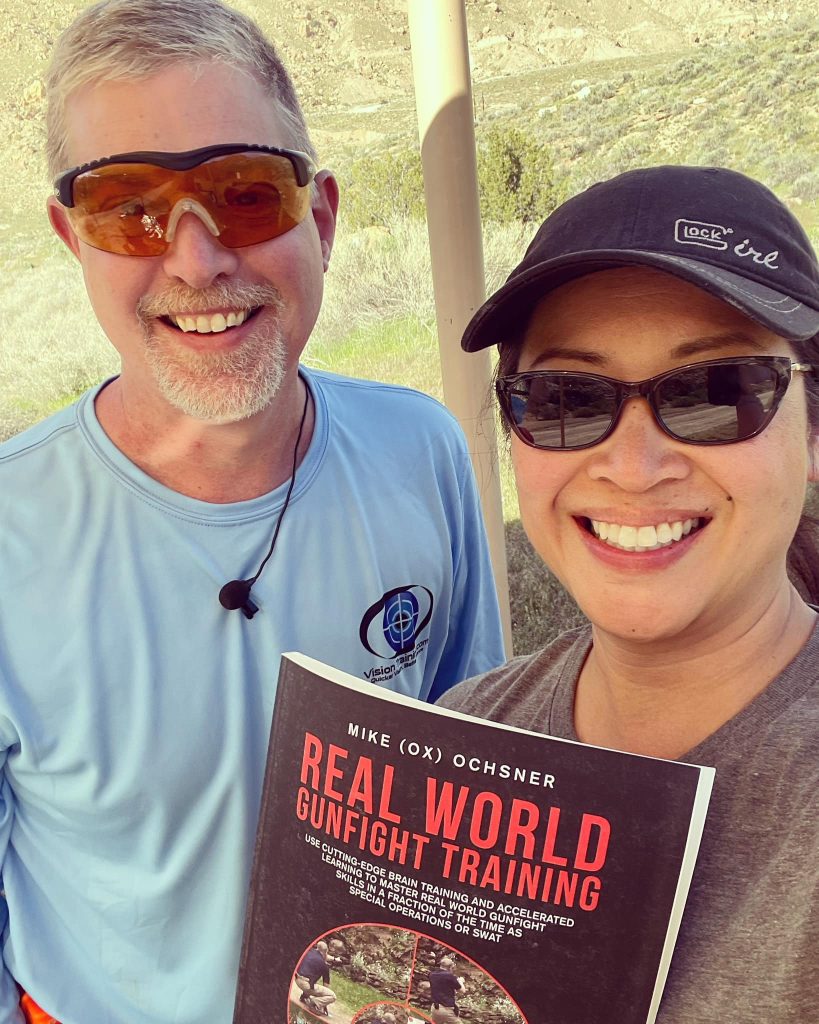Last week, I had the privilege to teach at the A Girl And A Gun national conference for the 6th year in a row. It was in beautiful Grand Junction Colorado at the Cameo Shooting Complex and it was another incredible experience.

600+ women shooters from all 50 states took blocks of instruction on everything from situational awareness, instructing, empty hands combatives, pistol, rifle, shotgun, force-on-force, engaging targets out to 2000 yards, working/shooting around cars, shooting from helicopters, and more. Some trained for 3 days, others for 5 or more.
Instructors came from all walks of life…civilian, law enforcement, military, professional shooters, and more.

And–really cool–we were supported by an incredible group of volunteer Range Donkeys (husbands) from around the country, as well as a few dozen volunteer RSOs from Cameo.
The event was put on by Robyn Sandoval and dozens of other organizers and they knocked it out of the park again.
I taught 6 half-day sessions this year…
Three were on tactical vision training with some balance, hand-eye coordination and movement integration as well.
We covered several topics on how to improve visual performance, the connections between vision, strength, and speed, how to correctly identify and stabilize eye dominance (the triangle-in-front-of-your-eye is incredibly unreliable), both eyes open shooting, and integrating vision, balance, and hand-eye coordination.
One of the big topics that we kept coming back to was the idea that bad sensory input = bad motor output, stress, and pain.
If the areas of the brain responsible for vision, balance, or hand-eye coordination are under-performing, the brain interprets it as a threat.
This increases the stress level we feel, increases perceived pain, impacts blood sugar levels, slows down reaction times, reduces speed, and reduces the percentage of muscle fibers that your brain is willing to activate when you flex.
In many cases we were able to lower the threat level in the brain and see immediate improvement in mobility, less pain, improved visual performance, and improved shooting performance. This resulted in some big hugs, lots of smiles, and some almost-tears, as some of them had been dealing with issues for years that they hadn’t been able to figure out.
Eye dominance was a big breakthrough for several shooters who had been mis-assessed for eye dominance in the past, which is incredibly common.
Eye dominance is really simple when the sights line up with the middle of a pupil, but 30ish% of the time, the sights line up with the corner of the eye rather than the pupil (and this alignment is unstable, shared, or partially suppressed) and 10ish% of the time, the sights line up with the bridge of the nose and can switch back and forth between the eyes.
What this means practically is that there are 4 types of eye dominance we should be testing for with shooters.
Traditional eye dominance tests force dominance assessments to one eye or the other and can create a TON of frustration for shooters with visual suppression issues or cyclopean dominance.
Simply put, if you imagine what the target sees as it looks back over the top of your sights at you as you’re shooting, the target should see your sights lining up with one pupil or the other. If the sights don’t line up with one pupil or the other each time the shooter presents the firearm, it introduces randomness and frustration.
There are dozens of reasons why dominance changes, including distance, light level, the angle you’re shooting at, the color of what you’re shooting, and more, but one of the biggest factors is that a single shooter can (and did) have 3 different forms of eye dominance based on whether they were holding a pistol in their right hand, left hand, or with both hands.
Eye dominance is contextual and the simple “triangle” or “circle” tests simply don’t cut it.
We cover how to address this in the See Quicker Shoot Quicker course and the results can be quick and dramatic. Here’s a pic from 2 years ago of us going over an assessment of each shooters’ eye dominance.

Several of the women came into the class having difficulty shooting with both eyes open.
Shooting with both eyes open doesn’t really matter for slow-speed or low-stress shooting, because you can simply close one eye. But both-eyes-open shooting is pretty darn important for self-defense shooting.
Not because of situational awareness, but because of the impact of closing one eye on how quickly and accurately you can see…ESPECIALLY in low light.

In full light, closing one eye can reduce reaction times by 10-30% and that reaction delay goes up as ambient light goes down.
In addition, closing one eye reduces the speed and accuracy at which we can process dynamic visual situations…simply put, keeping both eyes open allows us to see whether a potential threat that we’re covering becomes an immediate threat that we need to shoot faster and more accurately.
Having both eyes open also allows us to see whether presenting our firearm causes a clear and present threat to no longer be a threat…again, faster and more accurately.
We had some awesome results with some of the women…some good results with some…and doing the versions of the drills that we did was too much for others.
There’s a drill that I’ve done with well over 1,000 shooters that we did together. We stand at 10-15 feet and shoot 5x 1.5×4″ driveway reflectors for time.
Then we do 5 minutes of neurological drills…one biggie that I share in the Automatic Aiming presentation.
Then we re-test.
In one class, the average improvement in speed+accuracy with both eyes open with 5 minutes of vision drills was 47%!
VERY dramatic and quick change.
To give you an idea of how big of a deal this is, instructors are generally overjoyed when students get a 20% improvement in speed and accuracy over the course of a 2-3 DAY course. We’re getting more than that in a couple of minutes without changing gear or technique. We’re simply improving how the brain processes sensory input.
I have a dream that someday, every instructor will start every class with these drills…maybe call them “Ox’s reset drills” 🙂 and build all of their training and instruction on top of them.
Everyone didn’t improve…but why?
It could be fatigue, hunger, or something as simple as the last drill that we did before retesting being too much of a challenge for their brain at that moment.
Think about it this way…if you can work out with 100 pounds and decide to work out with 1 pound weights, you’ll get very little benefit. If you try to work out with 300, it will be too far beyond where you’re comfortable and your brain/body will have a negative reaction. But if you lift in the 102-104 pound range, it will be just far enough outside of your comfort zone that you optimize growth.
So we discussed how they could train when they got home to see the improvement they were looking for…how to properly combine drills in areas where they have issues with areas where they are strong.
That meant sharing different versions of the drills and how to incorporate “problem” drills into their training in a way to minimize frustration and maximize results by sandwiching the challenge drills between easy drills.
The vast majority of this training came from the See Quicker Shoot Quicker training and some from the Automatic Aiming training…both of which you can do at home.
If you’re an instructor, I’ll be teaching a 6 week live, online class on vision training for instructors in July. Comment below if you’re interested in attending.
Robyn, Wendy, Tatiana, and the rest of the A Girl and A Gun crew have done an incredible job of advancing womens’ shooting, with AGAG women-only shooting and training chapters from coast to coast, 2 national events per year, Back The Women In Blue training, and 2A work with The DC Project. What they’re doing is absolutely critical for the future of our right to own firearms and the freedoms that those firearms protect.
If you’re a woman, I want to strongly encourage you to get to an event like this (click HERE for more info). It’s great for women to shoot with men, but it’s especially valuable for women to spend time shooting with other women. The dynamic can be a huge help for many female shooters. Not watered down…just different.
In fact, one of the biggest reasons why woman only shooting events are so valuable is because there are no men around to coddle them. (The male instructors were all on board with this) At a woman’s only event, the women load their own mags, rack their own slides, haul their own gear, etc. When things don’t work, there are other women to share solutions that worked for them, but the goal is to help every woman be safe, competent, and capable with the guns they own or carry.
Why is this so important and why am I such a strong supporter of women’s shooting?
Because to a large extent, our future ability to own, shoot, and carry guns depends on getting women involved with shooting.
Women manage family schedules, family budgets, they vote, and they share their interests with others.
To be clear, we don’t just want more women “involved”…we want women to be safe, responsible, and effective shooters.
So, this Mothers’ Day weekend, if you want to get a taste of the training that we did at Conference, check out this free tactical vision training presentation or this free counter-assault training presentation and, if you want to take the next step and learn how to build hours of skill in minutes of training just sign up for the training I mention at the end of the presentations. And here’s something to sweeten the pot…for everyone who signs up for Automatic Aiming or Praxis this weekend, I’ll donate access to the full training to A Girl and A Gun 🙂
Questions? Comments? Fire away by commenting below…
1 Comment
Tim
May 11, 2023Interested in instructor training for vision training
Leave A Response